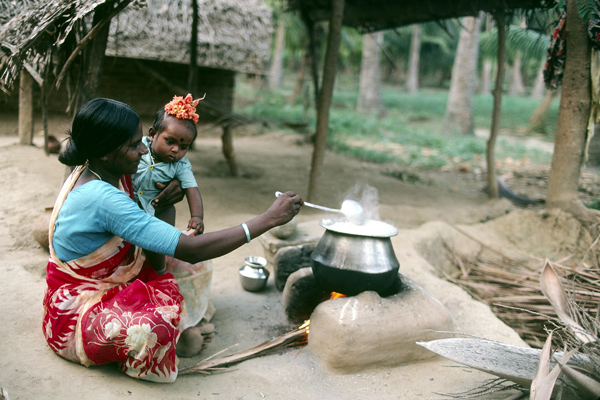India has never been known for investing in the health of its citizenry. The nation’s public expenditure on health hovers around 1% of its gross domestic product; it is among the lowest in the world. This makes the recent decision to slash the health budget by 20% appalling.
The move will not just deflate citizen health; it will inflate poverty.
India carries the grotesque burdens of both extremes of income. While its rapidly growing middle class and rich are being hit by life style diseases, the lower strata continues to suffer from diseases related to poverty. And, while there is rapid growth in the private medical sector – with even conservative estimates pegging it at 15% per year – the decline in the public health system is equally drastic. Most primary and community health centres, i.e. the mainstay of poor people’s access to healthcare, are in disarray, with the few quality specialty public hospitals strained to breaking point.

Photo: A woman cooking rice in the village of Melsanakuppam in Tamil Nadu, South India. UN Photo/P. Sudhakaran
The proposed cuts will hit the poor hardest. It is a known fact that – given the virtually nonexistent social security or health insurance cover – most health expenditure in India, especially for the poor, is out of the pocket expenditure. Studies have shown that medical emergencies are often the primary reason behind poor families slipping into destitution and/or debt bondage. And, the government is fully aware of this fact.
The draft of the government’s own national health policy estimates that “catastrophic” expenditure on healthcare neutralizes any gains made by rise in income and social welfare benefits targeted to reduce poverty, forcing 63 million Indians to face poverty every year.
The draft also indicates how medical expenditure is significantly higher in rural areas – itself an indictment of urban centric health infrastructure. The data also exposes the increasing burden of healthcare expenditure correspondent to cuts in public expenditure on health. The draft policy notes that 18% of all households faced catastrophic expenditure on healthcare in 2011-12; this represents a 3% rise from 2004-05 figures.
The concerns are reciprocated by other studies: the real life prevalence of malnutrition, for instance. A recent UNICEF study found that every year more than a million children under 5 die due to malnutrition related causes. The numbers are far above the emergency threshold guidelines of the WHO and require the Indian state to recognise acute malnutrition as a medical emergency. Unfortunately, it is not simply a matter of malnutrition deaths, with severe wasting and stunting causing lifelong health problems for survivors.
Add to this a toll of 5.5 lakh deaths due to tuberculosis, most forms of which are easily curable; tuberculosis is often contacted by the poor due to poor living and working conditions. Malaria kills another 1.2 lakh annually. Most of the people who perish to these diseases are poor while the government keeps focussing on the state of the art hospitals for tertiary care catering to the lifestyle diseases, or the diseases of the rich. It is high time for the government to rethink and re-strategize its health policy with a holistic approach linking sanitation and clean water, at the least, to primary health care.
The government should be increasing the expenditure on health instead of cutting it so drastically. Fiscal strains or not, it makes no slash expenditure on healthcare only to be forced to spend much more on fighting diseases and poverty both.